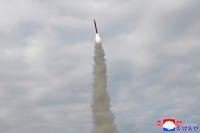SAN DIEGO - An annual Navy survey of sailors shows that, while the service is making progress on improving its culture, stress for the rank and file is continuing to grow.
The data, released Thursday, shows that more than one-third of sailors surveyed reported feeling severe or extreme levels of stress in 2023. The problem appears to be getting only worse. In 2019, only 26% of sailors surveyed had the same stress levels.
In a statement released alongside the report, the Navy acknowledged that "sailor well-being continues to be an area of concern" and that the overall satisfaction with the work-life balance sailors experience in general "continues to be suboptimal."
Read Next: 250,000 VA Patients Are at Risk of Receiving Wrong Medication Due to Electronic Health Records Issue
A Navy official told Military.com that "senior Navy leaders are encouraged by a lot of the results from the 2023 Health of the Force Survey, such as improved morale, trust, culture and protective factors, but remain cognizant that there is still work to do in providing sailors the tools needed to better manage stress and burnout."
The official added that "initiatives in 2024 will help to directly address these issues."
Navy leaders have begun to talk more frequently and openly about the need to improve sailors' quality of life in the past several months.
The survey, which began in 2019, randomly taps thousands of sailors across the fleet and in various ranks to answer questions about their experience in the Navy. The 2023 survey had 19,380 participants.
The data shows that junior enlisted -- sailors between the ranks of E-1 and E-6 -- are bearing the brunt of the stress. In 2023, more than 40% of that group reported severe or extreme stress levels. In contrast, only 30% of junior officers and 27% of senior officers felt the same way.
"Since 2019, inadequate manning has topped the list of reasons for heightened stress levels," the report said.
The Navy's top personnel officer, Vice Adm. Rick Cheeseman, told reporters in January that the service is short about 22,000 junior sailors at sea. That figure is driven in large part by several years ofrecruitment struggles that are not unique to the Navy.
However, the Navy managed to attract only 30,236 recruits, falling nearly 20% short of its goal of 37,700 sailors. It also recruited only 2,080 officers, almost 18% short of its 2,532 officer goal.
Alongside the rising stress levels in the fleet, the survey also found that burnout -- sailors being exhausted and disengaged from their jobs -- is a significant problem.
Between 2019 and 2021, the number of sailors reporting high levels of burnout went from 20% to 28%. In this latest survey, the total dipped slightly to 27%.
"Consistent with the results for stress, results indicate that E-1 through E-6 are most likely to have high levels of burnout," the report said.
A Navy official told Military.com that the data showed that leadership was less of a causal factor for stress and burnout than in previous years, falling from the fourth-highest reason cited in 2019 to sixth in 2023.
When sailors were asked about the morale at their command, most didn't describe it as high or very high. Instead, the vast majority of sailors -- 60% -- said morale was moderate or low. Also, 13% of sailors said morale at their unit was very low.
The morale figures are a slight improvement over 2021, though, when the Navy was dealing with the strains and stresses of the COVID-19 pandemic.
Another detail revealed in the survey was a disconnect between leadership and the junior enlisted. In 2023, only 22% of the participating E-1 through E-6 sailors said their command morale was high. In contrast, 41% of the senior enlisted sailors and 50% of participating O-4 through O-6 officers -- the group that would include most of the Navy's ship commanders -- said morale was high.
Meanwhile, the Navy has managed to make progress on the culture of the fleet, and the data shows that most sailors have trust in the enlisted and senior leadership at their individual commands.
"A majority of both male and female participants, across all grades, agree that they trust their commanding officer (CO) to do the right thing," the report said.
The number of sailors who agree with the statement that racism is not a problem in the Navy has steadily grown across the years, though in 2023 only 17% of Black sailors agreed with that sentiment.
The Navy also made inroads with women on sexism. In 2023, 13% of women agreed that sexism wasn't a problem in the Navy, up from only 9% in 2022.
The Navy's statement noted that those data points are "initial signs of improvement," but added that additional work is needed.
The statement also highlighted the fact that the number of junior enlisted and officers planning to remain in the Navy until retirement "rebounded from 37% and 35% in 2022 to 44% and 40% in 2023, respectively."
The report noted that sailors who were unsure about making the Navy a career "most commonly cited influences to leave include civilian career opportunities, salary, difficulty balancing work and their personal life, a desire to focus on the family, and the climate at their current command."
Related: The Navy's Personnel Boss Is Confident Data Can Fix the Service's Recruiting Woes














